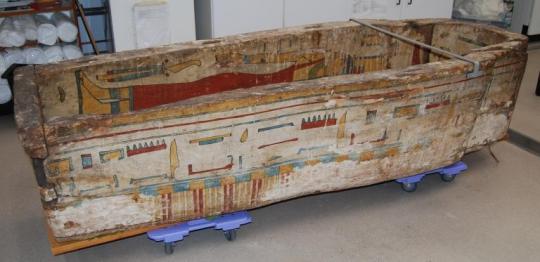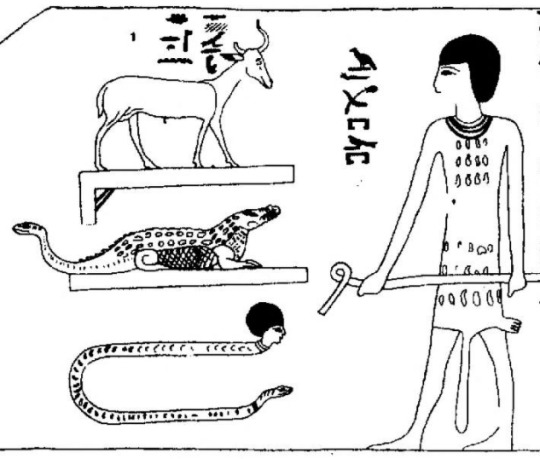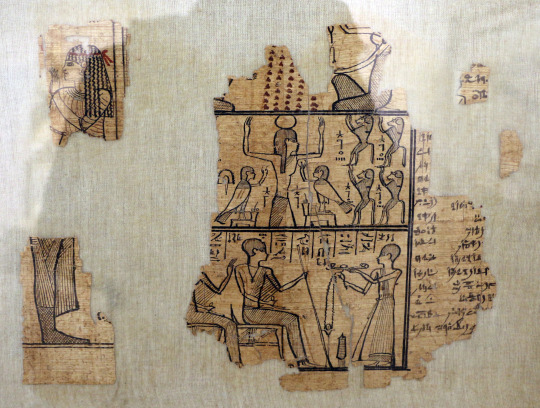Text

Sekhmet sees what you did there.
When: Late Period
Where: Royal Museums of Art and History, Brussels
39 notes
·
View notes
Text
A look inside the head part of Ankhefenamun's coffin. We can see the sundisc and left wing of Ra-Horakhty, who is worshipped by Isis, the deceased, and the deceased's ba.
#Ancient Egypt#coffin#Ra Horakhty#Isis#Third Intermediate Period#21st Dynasty#National Museum of Finland#Ankhefenamun
11 notes
·
View notes
Text
On this stela, painted grey and decorated in red, white, and black, the priest Nachtefmoet offers incense to Ra-Horakhty. The god, at left, is seated on a throne and holds a flail. On the left side, the symbol of the East stands atop of a red, white, and black-striped pole; a similar pole on the right has the symbol of the West.
When: Third Intermediate Period, some time after the 21st Dynasty
Where: Rijksmuseum van Oudheden, Leiden
#Ancient Egypt#stela#Ra Horakhty#Rijksmuseum van Oudheden Leiden#Third Intermediate Period#Nachtefmoet
13 notes
·
View notes
Text
Naughty baboons parade on the coffin of Sensaos. (There are three of them, hands raised in worship, and they sport erect penises.) In front of each is a short column painted red which looks like it was supposed to contain hieroglyphs.
When: Roman Egypt
Where: Rijksmuseum van Oudheden Leiden
10 notes
·
View notes
Text

Damien Hirst, The Severed Head of Medusa, 2013
42 notes
·
View notes
Text
A walking serpent brings cloth on the coffin of Teuris (Diuhor).
When: Roman Egypt
Where: Allard Pierson Museum
5 notes
·
View notes
Text

I've never seen anything like Padiamun's coffin, with its almost childlike decoration. The Egyptians liked their funerary gear personalised; I wonder if this is unique, or just unusual. (I'd joke that it was cut-price, but we get a glimpse of conventional decoration inside.)
ETA: Another one like it in this video clip -- the coffin of Iret-Hor-en-eru.
5 notes
·
View notes
Photo

2010_1106_130635AA EGYPTIAN MUSEUM TURIN by Hans Ollermann on Flickr.
The newly justified deceased Aaner celebrates, arms raised high, hhands holding maat feathers, two maat feathers decorating his head. He is supported by the goddess of the West, Amentet, who has an abbreviated version of her symbol for a head.
When: Third Intermediate Period, 21st Dynasty
Where: Egyptian Museum, Turin
#Ancient Egypt#papyrus#Amudat#Book of the Dead#Amentet#Museo Egizio Turin#Third Intermediate Period#21st Dynasty#Aaner
28 notes
·
View notes
Text

Forms of the great god on the papyrus of Nes-Amun-neset-taui. I'm not sure if the black snake between the two forms at right is coming out of the mouth of the left one with the gazelle head, or is part of the remarkable figure with a djed and an atef crown for a head (but no actual head!).
When: New Kingdom, 20th Dynasty
Where: Neues Museum, Berlin
10 notes
·
View notes
Text
This link should take you to a brief overview on mummies and coffins of the Third Intermediate Period (relevant to a lot of what I post here).
2 notes
·
View notes
Text
A stripy green cat walks on the coffin of Ameneminet.
#Ancient Egypt#coffin#Ancient Egyptian cats#Louvre#Third Intermediate Period#22nd Dynasty#Ameneminet
39 notes
·
View notes
Text

With the help of Google Translate I managed to struggle through the article "Mischgestalt" -- mixed forms -- in the German-language Lexikon der Ägyptologie. It mentioned a crocodile with a snake's head at the end of its tail, and a snake with a human head at the end of its tail. Well, I had to see those; found them in Heliopolis, Kaffr Ammar and Shurafa at archive.org. Fabulous!
Where: Atfiyeh, Tomb of Ast-Hetem
When: Ptolemaic Egypt
2 notes
·
View notes
Text

A snaky detail from Yuya's Book of the Dead.
Where: Egyptian Museum Cairo
When: New Kingdom
35 notes
·
View notes
Text

Fragments of a funerary papyrus.
When: Ptolemaic Egypt
Where: Egyptian Museum, Milan
32 notes
·
View notes
Text

Sometimes, however beautifully drawn the papyrus is, all that's left are fragments.
Where: Egyptian Museum Milan
When: Ptolemaic Egypt
34 notes
·
View notes




